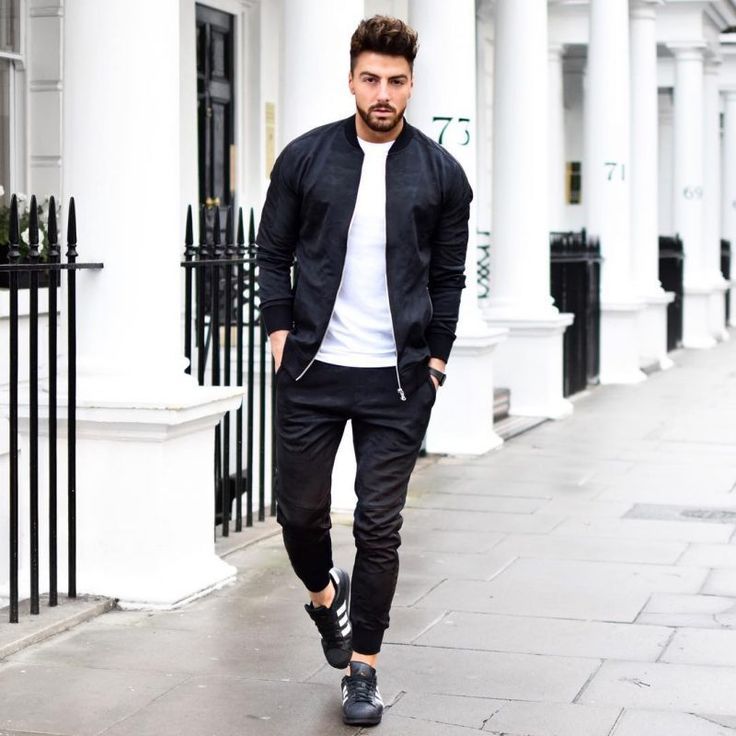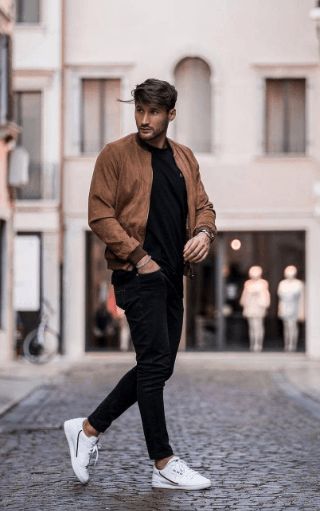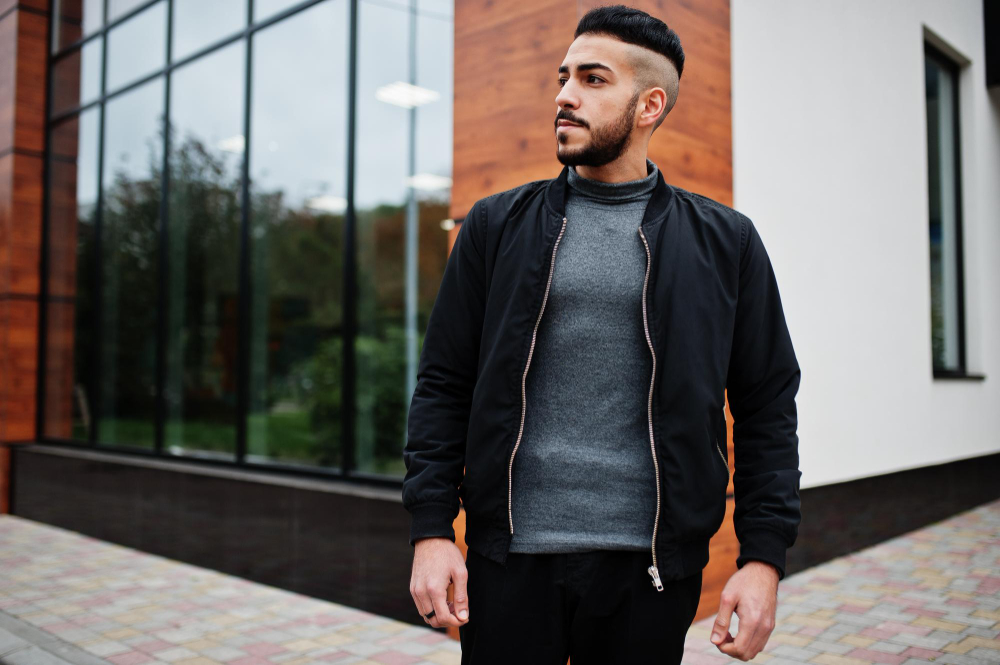Walk down any busy city street, New York, Paris, Tokyo, and you’ll see it. Not just once, but again and again, tucked into different shapes and styles. Sometimes it’s paired with ripped jeans and sneakers, sometimes with tailored trousers and Chelsea boots. The bomber leather jacket keeps showing up, decade after decade, reinvented but somehow untouched. It doesn’t shout, it just exists confidently, slightly rebellious, and completely timeless. But what is it about this piece of clothing that has managed to carve out its place as an icon of fashion?
The story isn’t just about fabric and cut. It’s about history, culture, and identity stitched into a single garment.
A Jacket Born in the Sky

To understand why the bomber holds its weight in the style world, you have to rewind to the early 20th century. Picture open cockpits, pilots braving the cold at high altitudes, leather caps pulled tight over their ears. Before jets had heated cabins, warmth meant survival. The U.S. Army Aviation Clothing Board introduced the first leather flight jackets during World War I. Heavy sheepskin and sturdy leather insulated pilots from freezing air at 20,000 feet.
By World War II, the jacket had evolved into the A-2 and later the B-3 bomber jacket, functional, rugged, and instantly associated with courage in the skies. Men who wore them weren’t just soldiers; they were modern knights, strapped into machines that pushed the limits of speed and danger.
That’s where the myth began. When the war ended, the jackets came home. Veterans wore them as reminders of service, and slowly, they trickled into civilian wardrobes. A piece designed for war had become part of everyday life.
From Battlefield to Big Screen
Fashion icons rarely stay icons without cultural boosters, and the bomber leather jacket got more than its fair share. Hollywood picked it up and never let go.
Think of Marlon Brando in The Wild One (1953), slouched on his motorcycle, cigarette dangling. He wore a leather jacket, not technically a bomber, but it cracked open the association between leather and rebellion. Then came Steve McQueen, the “King of Cool,” who practically lived in his brown leather flight jacket. James Dean in Rebel Without a Cause sealed the deal, even though his was closer to a red windbreaker. By the time Tom Cruise stepped into Top Gun in 1986, the bomber jacket wasn’t just clothing; it was an attitude.
Hollywood taught us that wearing leather on your shoulders meant more than keeping warm. It meant daring. It meant you weren’t afraid of rules.
Why It Keeps Coming Back
Trends rise and fall, wide ties, skinny jeans, neon windbreakers, but the bomber jacket has a strange immunity. Every few years, designers pull it back into the spotlight with a tweak: slimmer cuts, cropped versions, oversized silhouettes. So why hasn’t it slipped into the “retro-only” category?
Versatility. The bomber is a blank canvas. A black leather bomber can look sharp over a crisp shirt, while a distressed brown one pairs naturally with denim and boots. Streetwear fans might wear it oversized with hoodies, while luxury brands craft buttery-soft versions with sleek tailoring.
Balance of rugged and refined. Few pieces manage this duality. A bomber jacket carries the toughness of leather but has a simple, almost minimalist design with ribbed cuffs, a fitted waist, and clean lines. That balance makes it wearable across ages and personalities.
Cultural memory. Even if you don’t think about it consciously, the bomber carries echoes of history: pilots, rebels, rockstars. Put one on, and you’re plugging into decades of meaning.
Seasonless appeal. Unlike heavy coats or flimsy summer layers, a bomber works in transitional weather. It’s the jacket you reach for on October evenings and early spring mornings. Practicality has a way of keeping things alive.
The Leather Factor

There are bombers made in nylon, wool, even satin, but when people talk about the icon, they mean leather. Why? Because leather tells a story in a way no synthetic can.
A new leather bomber starts stiff, maybe even squeaky. Over time, it loosens. Creases form on the elbows, the collar softens, and the sheen dulls into a matte patina. It ages with you. No two jackets end up alike. That personal evolution, almost like the jacket recording your movements, your habits, your nights out, gives leather a human quality.
And let’s be honest: leather just feels different. The weight of it on your shoulders, the faint earthy smell, the way it warms to your body, it’s sensory in a way that fabric jackets rarely achieve. That tactility reinforces the bomber’s staying power.
Subcultures and Street Cred
What keeps a garment iconic is not just its origin but its adoption by different tribes along the way. The bomber jacket has traveled through more subcultures than most pieces of clothing ever will.
Military vets kept wearing them after service, giving the bomber a rugged, masculine image.
Mods and skinheads in 1960s Britain adopted nylon bombers, making them a part of working-class street fashion.
Hip-hop culture embraced oversized leather bombers in the ’80s and ’90s, often custom embroidered with logos or patches.
High fashion turned it luxe, with labels like Saint Laurent and Balenciaga pushing sleek reinterpretations on the runway.
The bomber isn’t locked to one group; it shifts meaning depending on who wears it. That flexibility has kept it alive across continents and generations.
The Psychology of Putting One On
Clothes do more than cover the body; they shape the way we feel. Slip into a bomber leather jacket, zip it up, and something changes in posture. Shoulders straighten, steps feel heavier but more deliberate. There’s a subtle armor effect that shields you, but not in a way that hides you.
That psychological kick matters. In a world where trends move fast, a garment that reliably makes people feel a bit cooler, a bit tougher, a bit more confident will never vanish.
Modern Takes and Future Longevity
Today, the bomber jacket is everywhere: high-street shops, vintage stores, and luxury boutiques. Some are lined with shearling, some come cropped, and some are vegan leather alternatives. But the essential silhouette, the cinched waist, the short body, the rounded shoulders, remains intact.
Will it stay iconic another fifty years? Almost certainly. Because it isn’t just fashion, it’s function, history, and identity all layered together. As long as people crave a jacket that tells a story and carries a whisper of rebellion, the bomber will have a place.
Final Thought
So, what makes the bomber leather jacket an icon of fashion? It’s not a single reason; it’s a constellation. Born from war, elevated by Hollywood, reimagined by countless subcultures, and held together by the enduring charm of leather. It’s adaptable, practical, and deeply human in the way it wears over time.
Fashion has its fads, but icons live outside of trend cycles. The bomber jacket is proof of that. It’s more than a jacket, it’s a symbol, a feeling, a little piece of armor that makes the everyday sidewalk feel like a runway.
Recommend0 recommendationsPublished in Uncategorized






